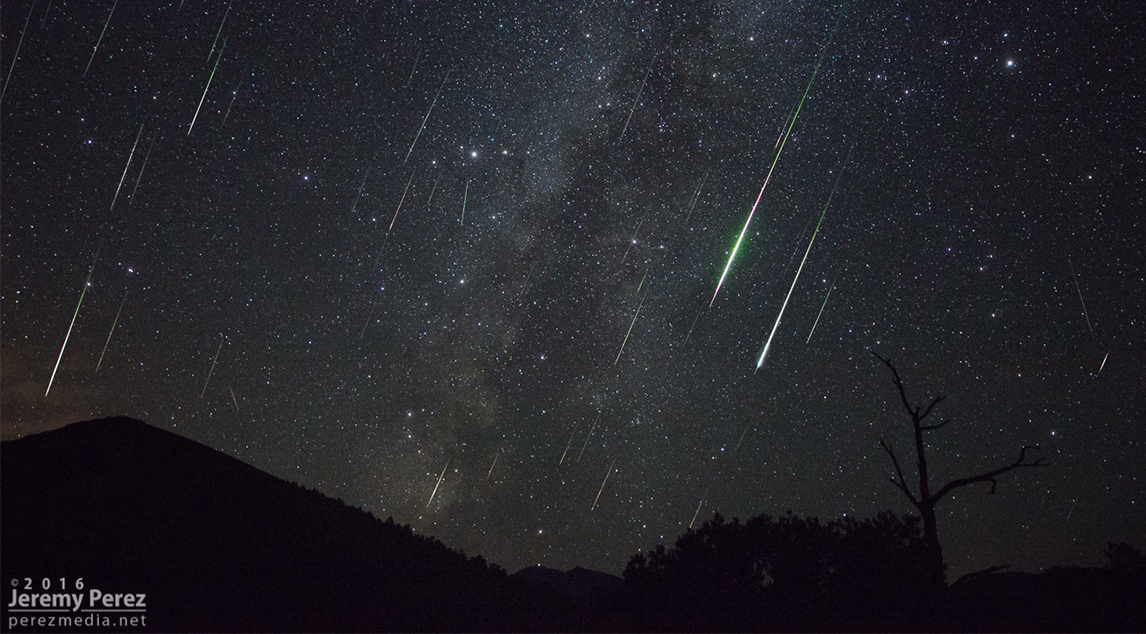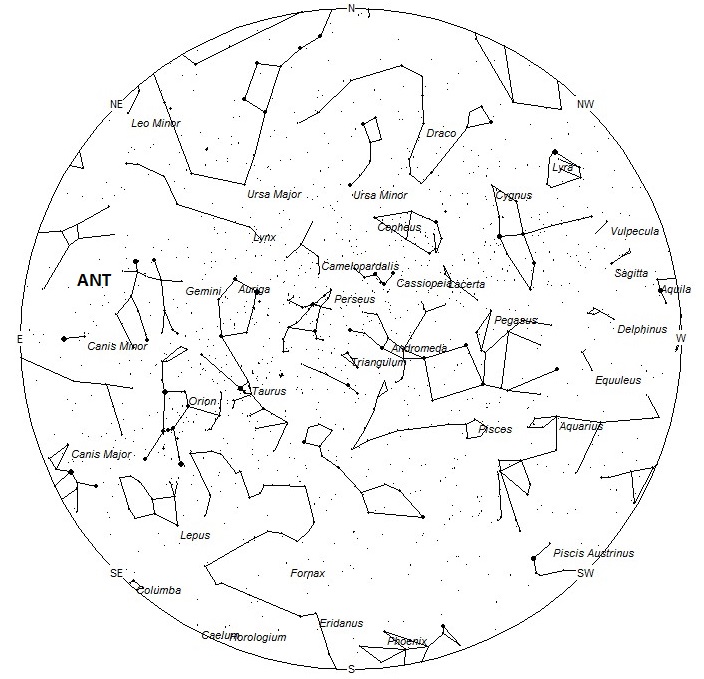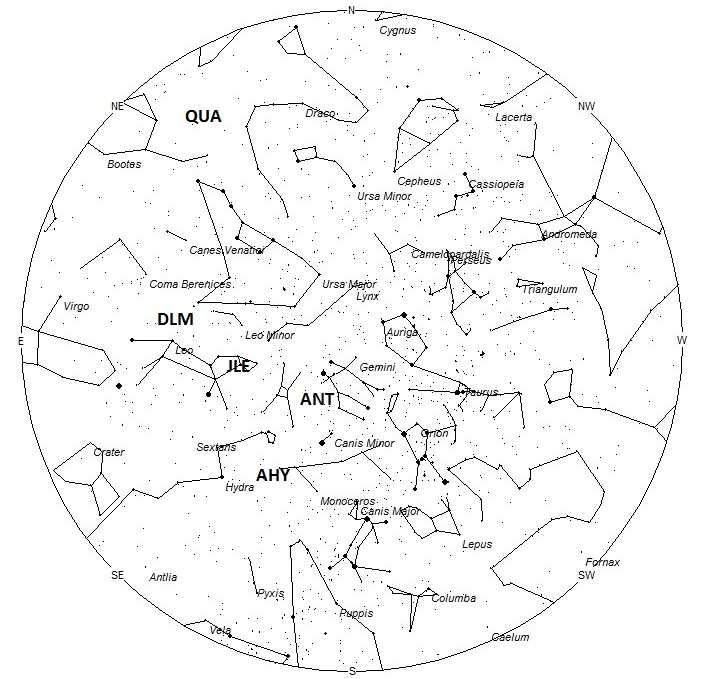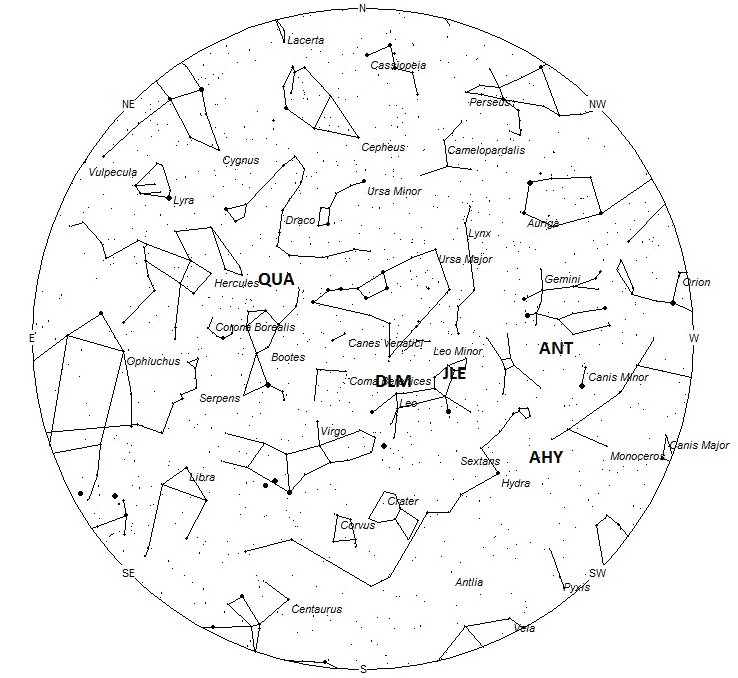
During this period the moon reaches its first quarter phase on Thursday January 5th. At this time the moon will be located 90 degrees east of the sun and will set between midnight and 0100 local standard time (LST). This weekend the waxing crescent moon will set during the early evening hours and will not cause any problems due to the thin phase. The estimated total hourly meteor rates for evening observers this week is near 3 as seen from mid-northern latitudes (45N) and 2 as seen from tropical southern locations (25S). For morning observers the estimated total hourly rates should be near 13 as seen from mid-northern latitudes (45N) and 7 as seen from tropical southern locations (25S). The actual rates will also depend on factors such as personal light and motion perception, local weather conditions, alertness and experience in watching meteor activity. Note that the hourly rates listed below are estimates as viewed from dark sky sites away from urban light sources. Observers viewing from urban areas will see less activity as only the brightest meteors will be visible from such locations.
The radiant (the area of the sky where meteors appear to shoot from) positions and rates listed below are exact for Saturday night/Sunday morning December 31/January 1. These positions do not change greatly day to day so the listed coordinates may be used during this entire period. Most star atlases (available at science stores and planetariums) will provide maps with grid lines of the celestial coordinates so that you may find out exactly where these positions are located in the sky. A planisphere or computer planetarium program is also useful in showing the sky at any time of night on any date of the year. Activity from each radiant is best seen when it is positioned highest in the sky, either due north or south along the meridian, depending on your latitude. It must be remembered that meteor activity is rarely seen at the radiant position. Rather they shoot outwards from the radiant so it is best to center your field of view so that the radiant lies at the edge and not the center. Viewing there will allow you to easily trace the path of each meteor back to the radiant (if it is a shower member) or in another direction if it is a sporadic. Meteor activity is not seen from radiants that are located below the horizon. The positions below are listed in a west to east manner in order of right ascension (celestial longitude). The positions listed first are located further west therefore are accessible earlier in the night while those listed further down the list rise later in the night.
These sources of meteoric activity are expected to be active this week.
The center of the large Anthelion (ANT) radiant is currently located at 07:32 (113) +21. This position lies in eastern Gemini, 2 degrees east of the 4th magnitude star known as Wasat (delta Geminorum). Due to the large size of this radiant, Anthelion activity may also appear from western Cancer, and Canis Minor as well as Gemini. This radiant is best placed near 0100 LST, when it lies on the meridian and is located highest in the sky. Rates at this time should be near 2 per hour as seen from the northern hemisphere and 1 per hour from south of the equator. With an entry velocity of 30 km/sec., the average Anthelion meteor would be of slow velocity.
The alpha Hydrids (AHY) were discovered by Dr. Peter Brown and are mentioned in his article “A meteoroid stream survey using the Canadian Meteor Orbit Radar”. This shower is active from December 22 through January 7 with maximum activity occurring on December 31. The radiant is currently located at 08:24 (126) -08. This position lies in southwestern Hydra, 15 degrees west of the 2nd magnitude star known as Alphard (alpha Hydrae). These meteors are best seen near 0200 LST when the radiant lies highest above the horizon. At 43 km/sec. the alpha Hydrids produce meteors of medium velocity. Expected rates this week are less than 1 per hour no matter your location.
The January Leonids (JLE) were also discovered by Dr. Peter Brown and are mentioned in the same source as the Alpha Hydrids. This shower is active from December 30 through January 5 with maximum activity occurring on January 1st. The radiant is currently located at 09:48 (147) +24. This position lies in northwestern Leo, near the spot occupied by the 3rd magnitude star known as Ras Elased (Epsilon Leonis). These meteors are best seen near 0300 LST when the radiant lies highest above the horizon. At 59 km/sec. the January Leonids produce meteors of swift velocity. Expected rates this week are less than 1 per hour no matter your location.
The December Leonis Minorids (DLM) are a shower of long duration active from December 6th through January 18th. Maximum occurred near December 21st when rates may have reached 3 an hour. The radiant is currently located at 11:32 (173) +24. This position lies in northeastern Leo, 5 degrees northeast of the 3rd magnitude star known as Zosma (Delta Leonis). These meteors are best seen near 0400 LST when the radiant lies highest above the horizon. At 63 km/sec. the December Leonis Minorids produce mostly swift meteors. These meteors are visible from the southern tropics but not well seen from the deep southern hemisphere.
The Quadrantids (QUA) are active from December 28th through January 12th. Maximum occurs on January 3 when rates may reach 100 an hour from dark sky locations over western North America and the eastern Pacific area. The radiant is currently located at 15:12 (228) +50. This position lies in northern Bootes in a blank area of sky located directly between the stars known as Iota Draconis and Beta Bootis. These meteors are best seen during the last hour before dawn when the radiant lies highest above the horizon in a dark sky. At 41 km/sec. the Quadrantids produce meteors of moderate velocity. These meteors are visible from the southern tropics but not seen from the deep southern hemisphere.
As seen from the mid-northern hemisphere (45N) one would expect to see approximately 8 sporadic meteors per hour during the last hour before dawn as seen from rural observing sites. Evening rates would be near 2 per hour. As seen from the tropical southern latitudes (25S), morning rates would be near 6 per hour as seen from rural observing sites and 2 per hour during the evening hours. Locations between these two extremes would see activity between the listed figures.
| SHOWER | DATE OF MAXIMUM ACTIVITY | CELESTIAL POSITION | ENTRY VELOCITY | CULMINATION | HOURLY RATE | CLASS |
| RA (RA in Deg.) DEC | Km/Sec | Local Standard Time | North-South | |||
| Anthelion (ANT) | – | 07:32 (113) +21 | 30 | 01:00 | 2 – 1 | II |
| Alpha Hydrids (AHY) | Dec 31 | 08:24 (126) -08 | 43 | 02:00 | <1 – <1 | IV |
| January Leonids (JLE) | Jan 01 | 09:48 (147) +24 | 59 | 03:00 | <1 – <1 | IV |
| Dec. Leonis Minorids (DLM) | Dec 21 | 11:32 (173) +24 | 63 | 05:00 | 2 – 1 | II |
| Quadrantids (QUA) | Jan 03 | 15:12 (228) +50 | 41 | 10:00 | 1 – <1 | I |
 American Meteor Society
American Meteor Society



Could AHY or JLE have been the source of a mysterious blasts that were reported in the Central Southern Tier of NY/Northern Tier of PA and another in Northern GA at 4:45 pm December 31st?
Michael and All,
No, These sources were below the horizon at that time and could not have been responsible for any meteors or blasts.
Robert Lunsford
At 17 36 on the 03/01/2017 a meteor passed across the front of my window and was visible for 3 to 4 seconds, it came from the direction of North eastern Cyprus and went out over the sea in a south westerly direction. I got up from my chair to try to follow its path, it went out of sight behind very thick dark cloud and did not seem to come out from the cloud. I have seen shooting stars and meteors befor also Hayley’s comet but this was by far the brightest and closest I have ever seen. It was a very bright blue/white colour with a tail, an absolutely marvellous sight. Regards Trevor Linley, Chloraka, Paphos, Cyprus